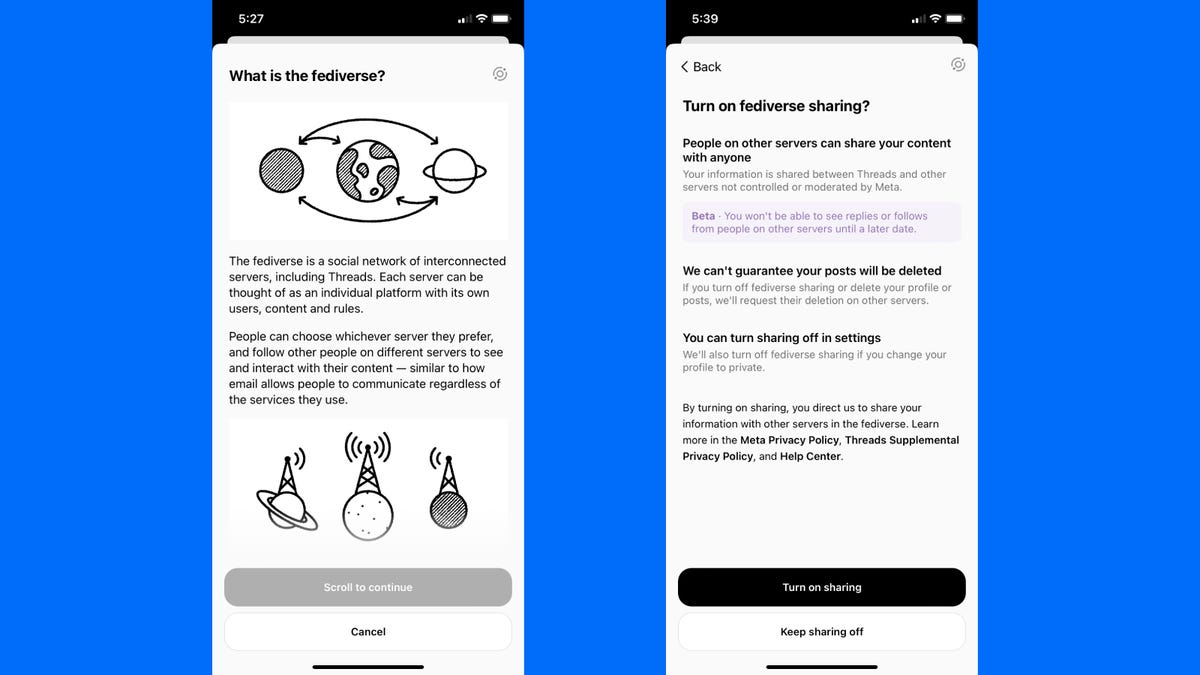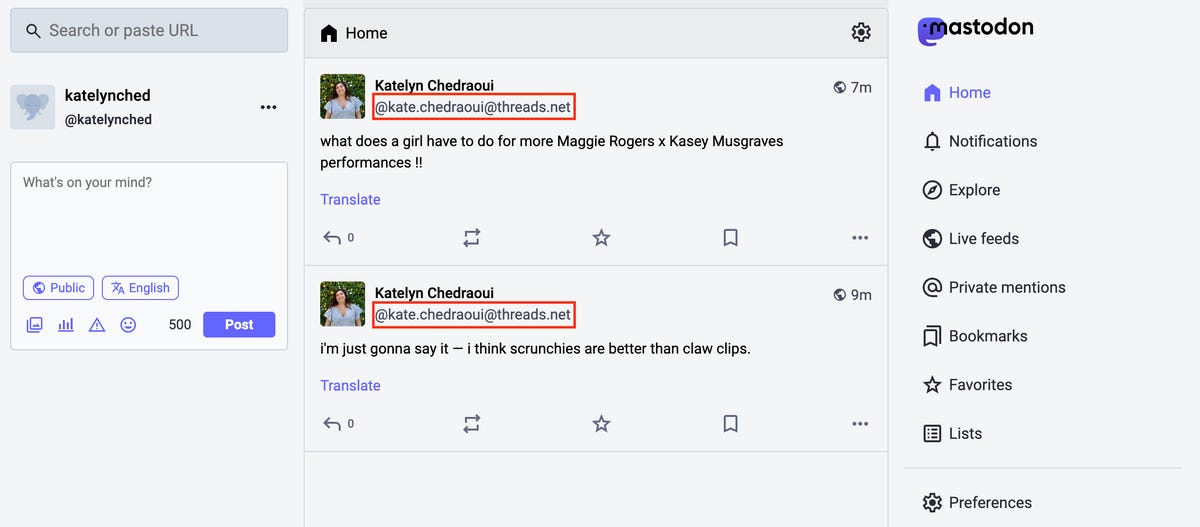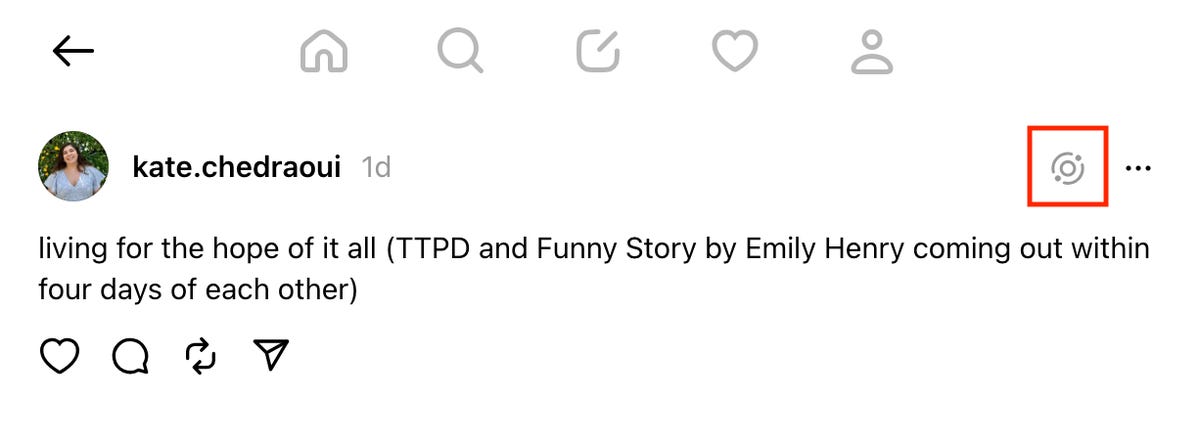The “fediverse” is a collection of social media platforms that can talk to each other. Meta announced on March 21 that Threads would be joining the fediverse. With its more than 130 million monthly active users, Threads is introducing millions of people to the fediverse.
Don’t panic — the way you use your Threads account won’t change. It just means you’ll have more opportunities to share your posts more widely, particularly with another popular platform in the fediverse, Mastodon. Eagle-eyed Threads users recently spotted President Biden’s Threads account taking advantage of the new feature.
Opting into fediverse sharing on Threads is easy. But when you dive a little deeper into what Meta’s involvement with the fediverse spells for the future of open source, decentralized social media… well, that’s when things get complicated.
Here’s what you need to know about the fediverse, and how to change your Threads settings to enable fediverse sharing.
Read more: What to Know About the Proposed TikTok Ban
What is the fediverse?
The fediverse is the term given to federated social media — platforms belonging to a larger group or organization. Federated social media platforms are united under a set of open-source, decentralized ActivityPub protocols, built by the World Wide Web Consortium, or W3C.
These protocols are a set of rules that structure the way social media sites are built and engineered behind the scenes. Social media apps that use these protocols can speak each other’s language, making it easier to share content across them. Think about email: You can read an email sent from your friend’s Yahoo account even if you use Gmail, no problem. That’s because email servers run on similar protocols, so they appear the same across clients.
With the fediverse, the ActivityPub protocols systematize social media posts so that posts from one social media platform are able to be recalled and shared on another. Currently, the biggest platforms in the fediverse are Mastodon, Threads and WordPress (via plug-in). So you can directly share your Threads posts onto any Mastodon servers and other federated platforms like image-focused PixelFed and video-focused PeerTube.
But there’s an important thing to note about the fediverse — it’s built around the ideas of being open-source and decentralized. That’s why Mastodon is usually discussed in the same breath as the fediverse — before Threads, Mastodon was the biggest platform in the fediverse and it’s a decentralized social platform, meaning it doesn’t operate on one main website. Instead, you can choose to join individual servers (also referred to as instances). You can follow and interact with people from other servers, but there’s no one main umbrella website for all Mastodon users.
What it means to join the fediverse on Threads
If you’re on Threads, you can now choose to opt into fediverse sharing. If you do, your Threads account and posts will be discoverable on all fediverse platforms, exposing your posts more widely. You can post on Threads, and people can like, reply and repost on Mastodon.

This is Meta’s explanation of fediverse sharing. Note that it can’t guarantee your posts will be deleted.
The eventual hope is that people will be able to access content from platforms without needing to sign up for accounts, Meta wrote in a blog post. When you turn on fediverse sharing, Meta prominently features its legal caveat that it “can’t moderate or control what happens to your content on other servers” once you share it outside of Threads. Meta also warns that it can only request the deletion of your content from servers in the fediverse, rather than guarantee deletion.
Meta will affect the future of the fediverse — we just don’t know how
Right now, the largest social media platforms using ActivityPub protocol are Threads and Mastodon, so if you’re not currently using those sites, it won’t affect you. And even if you are a user, the cross-posting feature is optional.
What’s most interesting about the fediverse and Thread’s decision to join is what this tells us about the future of text-based social media. Since users have started to flee X (formerly Twitter), a number of contenders have tried to claim the crown of the number one micro-blogging site. Mastodon and Bluesky are two popular Twitter alternatives, and Threads became another serious player when Meta launched it in July 2023.
According to Meta exec Adam Mosseri, the work to begin integrating Threads under ActivityPub protocols began late last year. He wrote in a thread that the rollout process would potentially be a year-long, as Meta systems “historically [haven’t] been designed with this use case in mind.”
The future of open-source, decentralized social media is a hot-button topic amongst experts and users, to say the least. Some fediverse fans have expressed concern that Meta, perhaps even unintentionally, may crush the network it wants to join. Or, as one former ActivityPub technologist and open source proponent put it, Meta may be more interested in colonizing, not integrating, the fediverse. Suffice it to say, it will be interesting to see how Meta’s entrance into the fediverse will be received long-term and what it means for both their futures.
How to turn on cross-posting on Threads and Mastodon
Meta is rolling out federated Threads in phases. In the initial phase, you will have to opt into sharing your threads across other federated social media platforms. Here’s how.
1. Open Threads.
2. Navigate to your profile.
3. Tap the two lines above your profile picture.
4. On mobile, tap Account. On desktop, click Settings, then Account.
5. Tap Fediverse sharing. Read through Meta’s disclosures.
6. Tap Next.
7. Tap Turn on sharing.
There are some limitations to what can be cross-posted in this initial phase. You’ll need to have a public profile. Threads can’t be cross-posted if they include pictures, polls, restricted replies or if they’re reposts from people who haven’t opted in. This may change as Meta rolls out updates. In my experience, fediverse sharing wasn’t instantaneous — it took about 15 minutes for one of my Threads posts to load in my Mastodon feed.

Here’s an example of my Thread posts being shared in the fediverse, specifically on Mastodon. You can tell it’s from my Threads account by looking at the username format.
Your Threads account will be searchable across the fediverse using the format “[your-Threads-username]@threads.net”. Posts you share on Threads going forward will be discoverable in the fediverse (your posts from before you enabled sharing will not). You can see which posts are shared in the fediverse by looking for the planet-and-orbit icon to designate your fediverse status. That’s how we know POTUS entered the fediverse, without an official statement from The White House.

This was my first Threads post that was shared across the fediverse, as indicated by the icon in the upper right corner.
Be aware that if you choose to turn off fediverse sharing, you’ll have to wait 30 days before you can turn it back on.




















+ There are no comments
Add yours